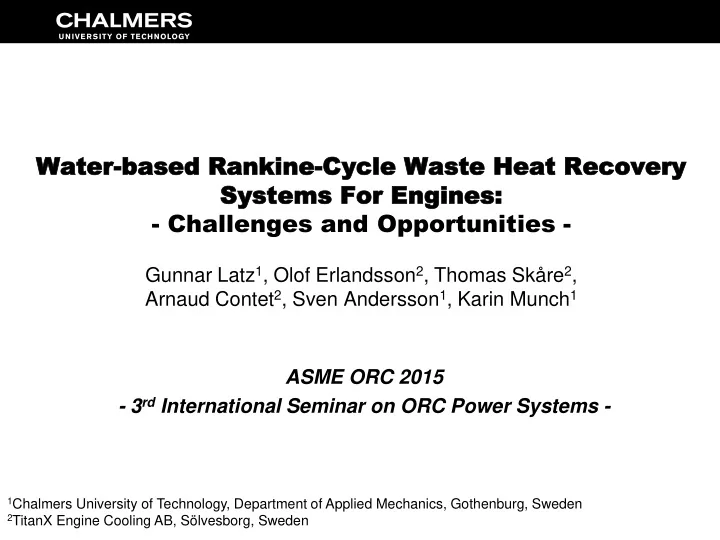

Wa Water ter-ba base sed Ran d Rankin kine-Cyc Cycle Was le Waste te Hea Heat R t Rec ecov overy ery Sy Systems stems For En For Engine gines: s: - Challenges and Opportunities - Gunnar Latz 1 , Olof Erlandsson 2 , Thomas Skåre 2 , Arnaud Contet 2 , Sven Andersson 1 , Karin Munch 1 ASME ORC 2015 - 3 rd International Seminar on ORC Power Systems - 1 Chalmers University of Technology, Department of Applied Mechanics, Gothenburg, Sweden 2 TitanX Engine Cooling AB, Sölvesborg, Sweden
Gunnar Latz Introduction Introduction Motivation : Energy balance Technology : Rankine cycle Waste heat (e.g. EGR) Evaporator Work output Expansion Rankine Fluid device Cycle pump Condenser Engine: Volvo D13, B75
Gunnar Latz Outline Outline • Motivation • Method • Results • Conclusion
Gunnar Latz Motivation Motivation
Gunnar Latz Motivation… …for the project and the study • Build a research demonstrator (full-cycle+ engine) • Validation of components models • Identification of challenges on component level in a full scale test rig …for water as a working fluid • Non flammable/poisonous • Thermal stability • Availability • Performance (?) Keep it simple!
Gunnar Latz Method Method
Gunnar Latz Method – Test Method Test rig rig layout layout Flow EGR out Working fluid EGR in meter Coolant Lubricant Focus of this study EGR Boiler Piston expander Bypass Pressure relief Flow Pressure meter relief Oil Oil pump separator Oil Tank Oil Expansion tank cooler Heater Coolant out Pump Fluid receiver Condenser Coolant Filter in Coolant out
Gunnar Latz Method Method – Component simulation Component simulation Piston expander (2 cyl., uniflow) Inlet T • Bore/stroke: 90/60 mm ( Ɛ geometric =21) Outlet • Inlet opening/closing: -17º/34º ATDC • Outlet opening/closing: 110º/250º ATDC • Modelling: GT-Suite (1D)
Gunnar Latz Method Method – Component simulation Component simulation Piston expander (2 cyl., uniflow) Inlet T • Bore/stroke: 90/60 mm ( Ɛ geometric =21) Outlet • Inlet opening/closing: -17º/34º ATDC • Outlet opening/closing: 110º/250º ATDC • Modelling: GT-Suite (1D) EGR boiler (plate type, counterflow) EGR • Channels fluid/gas: 22/21 (vertical) Vapor out • Fin geometry: Offset strip fin • Core length/height: 458/95 mm Fluid in • Modelling: 0D lumped element, CFD (Ansys)
Gunnar Latz Method Method – Tests p Tests perf erformed ormed ESC* operating points 100 Engine ** load [%] 75 50 25 A B C 0 1000 1200 1400 1600 1800 2000 Engine speed [rpm] Rankine expander bypassed Rankine expander engaged All ESC points Focus on A100/B100 *ESC = European Stationary Cycle, **Engine: Volvo D13 US10
Gunnar Latz Res Results ults – EGR EGR Boiler Boiler
Gunnar Latz Results – EGR Results EGR boiler boiler (t (test ri est rig) g) EGR ~7 ~70% % 30 bar compared to 10 bar st standard Water EGR EG R cooler ler 1 bar EGR EGR aftercooler ESC operating range
Gunnar Latz Results Results – EGR EGR boiler boiler CFD (Ansys) Vapor phase volume fraction [-] Simulation HT (water) [kW] Vapor out EGR x 0D model – – 1:1 Fluid in Experiment HT (water) [kW] IR camera image, B75 400ºC 300ºC 200ºC EGR 100ºC ~B75 30ºC
Gunnar Latz Res Results ults – Pis Piston ton expan expander der
Gunnar Latz Results – Expander Results Expander (simu (simulated) lated) Expander power [kW], (model) Steam flow rate [g/s], (model) Expander speed [rpm] ε = 13 ε = 13 ε = 21 ε = 21 Inlet pressure [bar] Inlet pressure [bar] Hypothesis: Maintaining power output and expander efficiency at 30% lower admission pressure when modifying expander compression ratio from 21 to 13
Gunnar Latz Results Results – Expander Expander (test, (test, B100) B100) 13 Compression ratio 21 (base) 𝐹𝑦𝑞𝑏𝑜𝑒𝑓𝑠 𝑞𝑝𝑥𝑓𝑠 𝐹𝑦𝑞𝑏𝑜𝑒𝑓𝑠 𝑞𝑝𝑥𝑓𝑠 𝜃 𝑗𝑡𝑓𝑜𝑢𝑠𝑝𝑞𝑗𝑑 = 𝜃 𝑢ℎ𝑓𝑠𝑛𝑏𝑚 = 𝑁𝑏𝑡𝑡 𝑔𝑚𝑝𝑥 ∙ 𝐽𝑡𝑓𝑜𝑢𝑠𝑝𝑞𝑗𝑑 𝑓𝑜𝑢ℎ𝑏𝑚𝑞𝑧 𝑒𝑠𝑝𝑞 𝐹𝐻𝑆 ℎ𝑓𝑏𝑢 𝑢𝑠𝑏𝑜𝑡𝑔𝑓𝑠
Gunnar Latz Results Results – System System test ( test (B100) B100) 260ºC 550ºC EGR boiler 62ºC 230ºC 18.6 bar 18.5 bar 600 Expander Fluid 500 ε = 13 pump 400 P= 2.36 kW T [°C] 11 g/s n = 780 rpm 300 ƞ is = 45 % 2000 kPa 200 1000 kPa 100 101,3 kPa 103ºC 1.16 bar 0,2 0,4 0,6 0,8 0 0,0 2,0 4,0 6,0 8,0 10,0 s [kJ/kg-K] 64ºC 1.05 bar Condenser
Gunnar Latz Conclusion Conclusion
Gunnar Latz Conclusion Conclusion EGR boiler • Internal flow circulation (steam “bubble”) reduced area for effective heat transfer • EGR aftercooler was required to maintain sufficient EGR cooling Piston expander • High re-compression ratio of current expander design constrained power-output at applied boundary conditions - Compression ratio 21 13: Maintained power @ 30% lower inlet pressure System tests with water • Large heat of evaporation and high boiling temperature: → Very low flow rates (< 15 g/s), challenging to control → Poor cooling of EGR
Gunnar Latz Authors - Contact information: Gunnar Latz (Chalmers) – latz@chalmers.se Olof Erlandsson (TitanX) – olof.erlandsson@titanx.com Thomas Skåre (TitanX) – thomas.skare@titanx.com Arnaud Contet (TitanX) – arnaud.contet@titanx.com Sven Andersson (Chalmers) – sven.b.andersson@chalmers.se Karin Munch (Chalmers) – karin.munch@chalmers.se Acknowledgements: Volvo Car r Corpo rporati ration
Recommend
More recommend